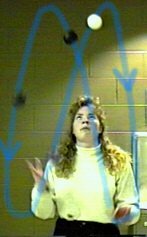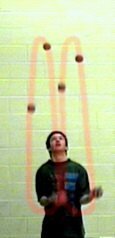
The 5 ball cascade
The up-side is that progress, while it comes less quickly, is greatly rewarding. When you have five or more balls in control, you know you've really earned that skill. It seems the more you work to learn a difficult pattern, the more amazing and wonderful it becomes. There's an amazing beauty to a clean pattern with a large number of objects, and feeling that pattern begin to take shape can be very exciting.
Ok, you've been warned, but hopefully not scared off. Now about numbers juggling:
For any odd number of objects, the usual pattern is the cascade. That is, the hands alternate making crossing throws, all of the same height. Juggling a five ball cascade is a lot like juggling a three ball cascade, except higher and faster.


For even numbers of objects, the asynchronous fountain is usually the preferred pattern. A six ball fountain consists of juggling three balls in each hand simultaneously.

So how do you hold all those balls? Different jugglers prefer different methods. Some hold up to four balls in a straight line up the palm, with one finger holding each ball in place. A fifth ball can sit against the others, held in place with the thumb. Others hold four in one hand in a pyramid. Try a variety of methods and see what feels most comfortable for you. Obviously using smaller balls will give you more options in the grip, but many jugglers find that particularly small balls are hard to throw with consistency. Similarly, loosely filled beanbags are easy to hold and easy to catch, but they may be more difficult to throw accurately than rounder balls.
It helps tremendously to be able to visualize the pattern you're trying to learn. That's a lot easier once you've watched a juggler who can already juggle that pattern. Watch other numbers jugglers at your juggling club, juggling festivals, or on videos. The more familiar the pattern is to you, the easier it will seem to learn it.
Notice that the best numbers jugglers remain relaxed even while juggling 9 balls or more. That's very important. To see just how much difference relaxation makes, try juggling 3 or 4 balls while tensing your muscles, holding your breath and clenching your teeth. It makes it much more difficult to juggle a smooth pattern. If you find yourself tensing and straining while practicing numbers juggling, take a break. Sit down for a few minutes and breathe slowly and deeply, then go try again. Warming up with smaller numbers before attempting a pattern near the current limit of your ability is also very helpful.
Keep track of your personal records. While some jugglers find it difficult to count while juggling a difficult pattern, others find that once it becomes habit, it actually improves their juggling. The counting can serve as a mental metronome, keeping a steady beat. Keeping track of your personal best can also be a big help motivationally. Finishing a run with 5 or more props and thinking it was a long one for you is a great feeling, but knowing that you just broke your personal record is even better.
If you're stuck in a rut and just can't seem to make any progress, have another juggler watch your pattern and look for problems, or watch yourself on video-tape. You may find that your pattern starts clean but gets lower until you loose control, or that one hand isn't scooping the balls far enough into the center before each throw, etc. It's a lot easier to fix a problem in your pattern once you know exactly what's going wrong.
As soon as a pattern begins to feel truly controlled and less demanding of your concentration, try a few tricks. First add a trick start, or trick finish to the pattern. Then try tricks within the pattern. This not only helps build your confidence in the pattern, but also helps make maintaining the pattern easier while you concentrate on the trick.
The Coulee Region Jugglers and Unicyclists (crju@jugglingpoet.com) 5/02